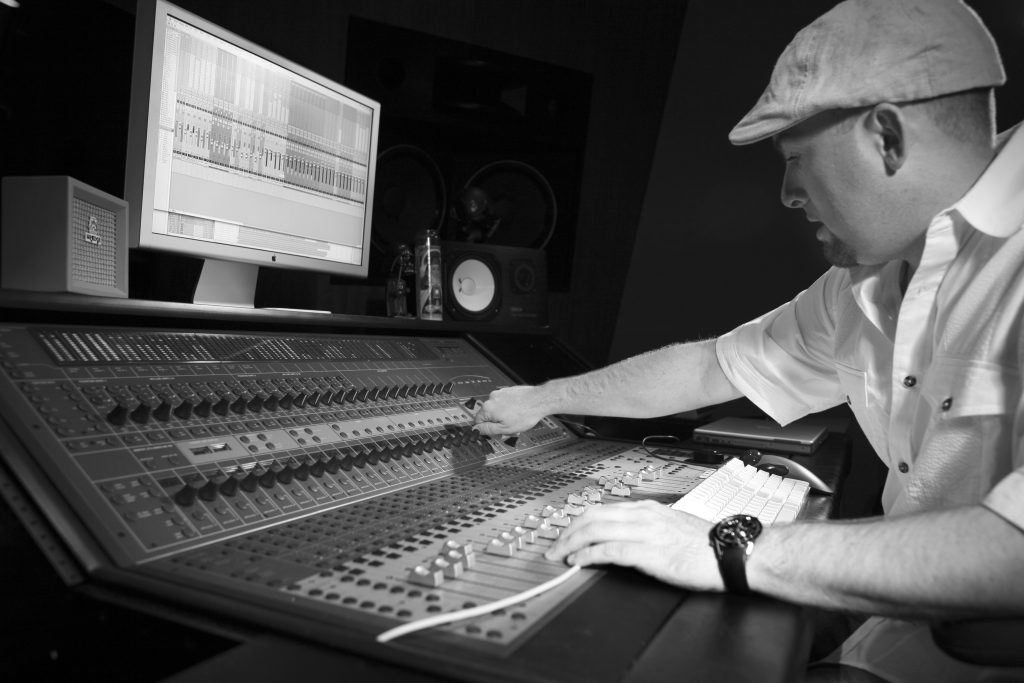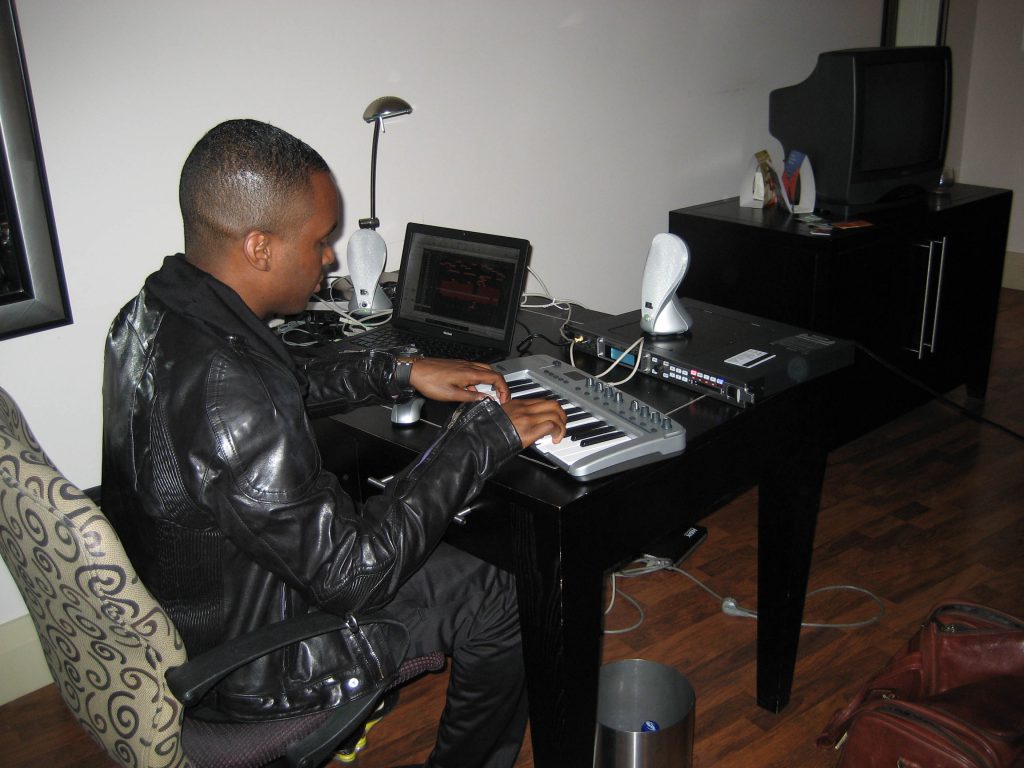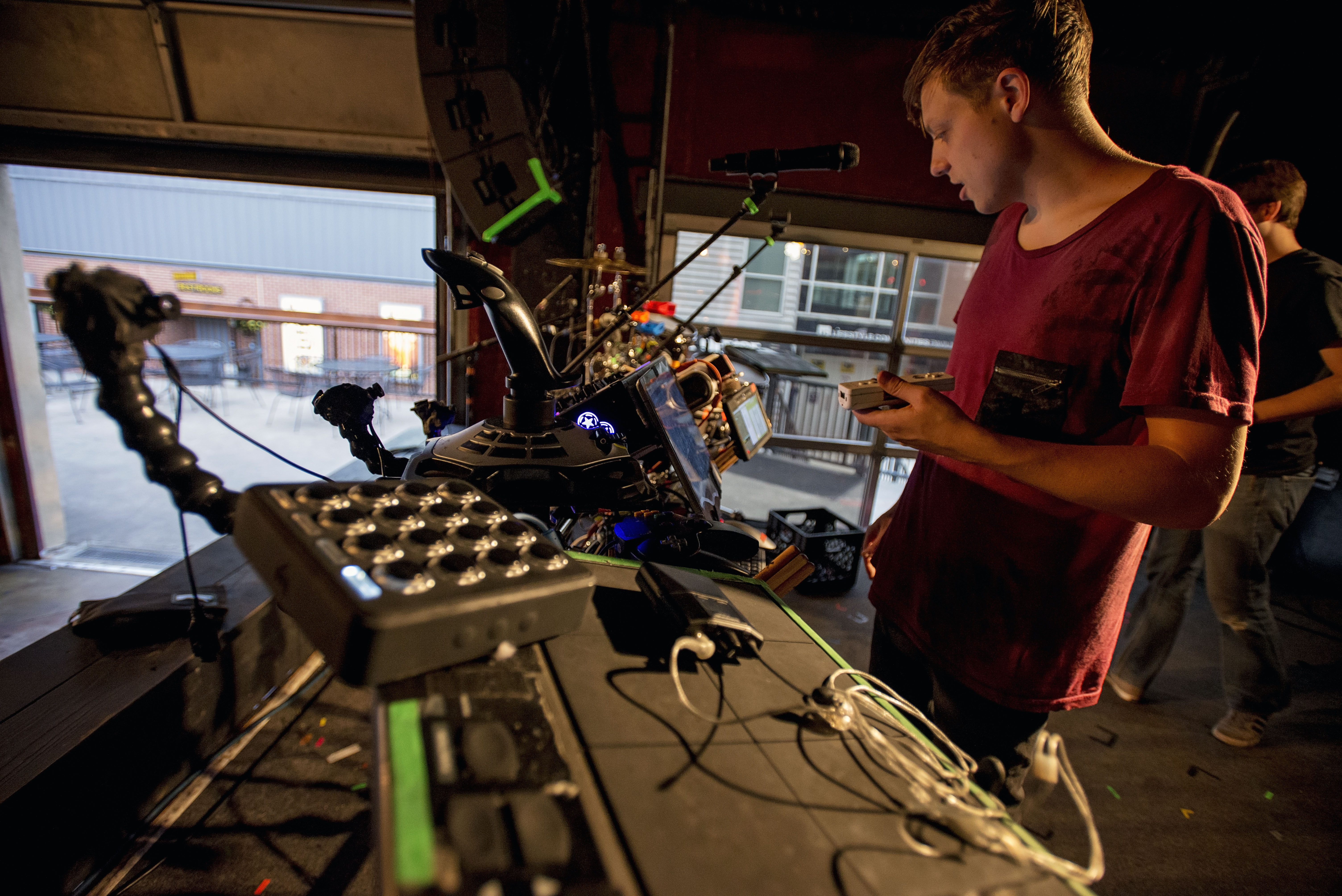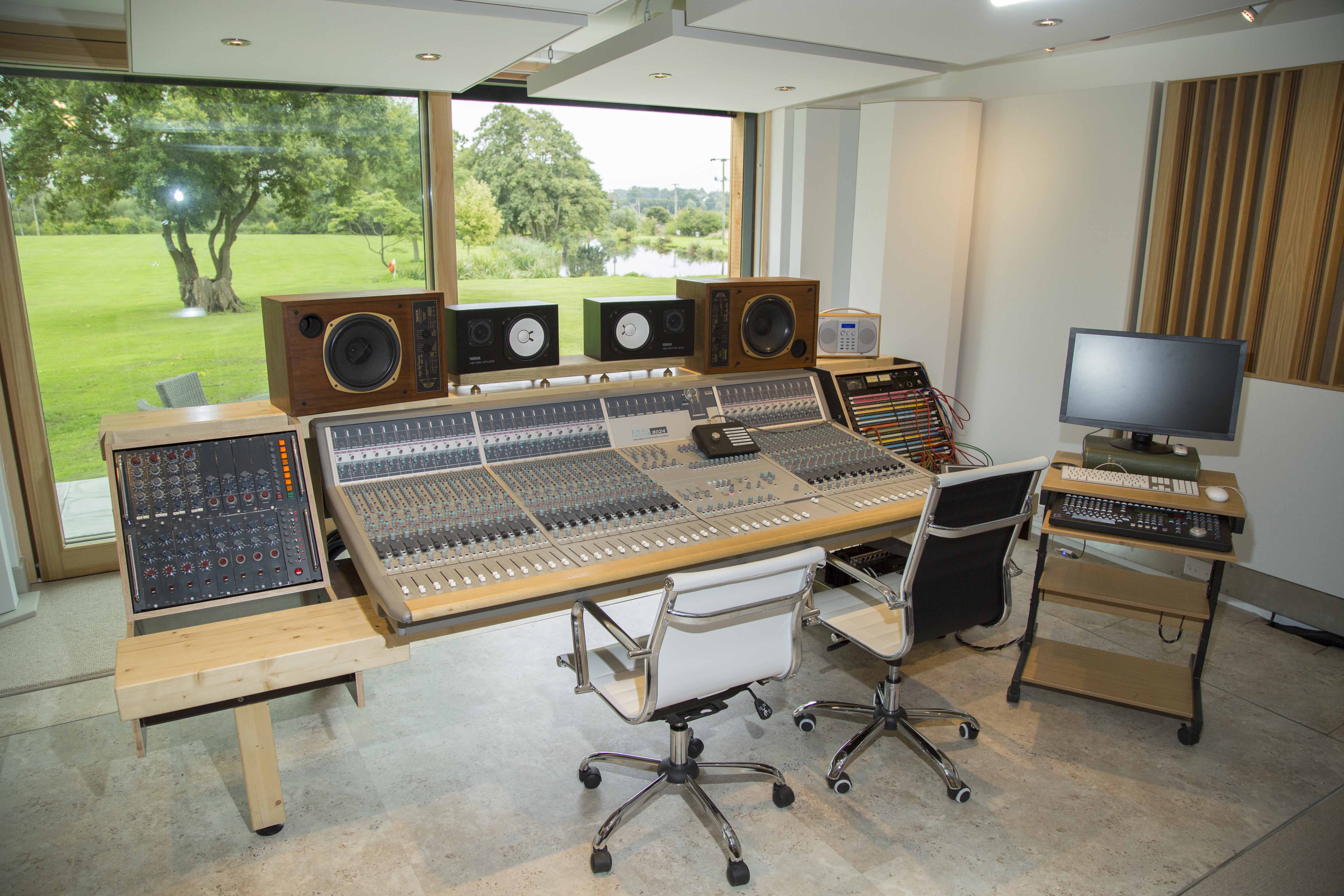Speaking during a brief tour break back in his home town of Atlanta, Mark ‘Exit’ Goodchild explains how he recorded R&B and hip hop artist, Akon, while on the road, and how the production team’s remix of Michael Jackson’s Wanna Be Startin’ Somethin’ took shape during a worldwide tour.

Mark Goodchild
It’s probably not too much of a generalization to say that the working life of a successful musical artist is split between intensive studio recording marathons and exhaustive promotional tours. For logistical reasons, the two disciplines are usually kept separate, even though an artist’s creative impulse to write and record is very-often at its peak when they are mid tour, thousands of miles from their favourite studio and first-choice engineering staff.
One solution is to travel with a portable studio, and that is exactly what Akon chose to do during the 2008 live tours he did with Gwen Stefani and Rihanna. By his side, recording everything and mixing some of the results, was Mark Goodchild, his engineer, who is now an expert at operating a Pro Tools rig while traveling at high speeds along the motorways of Canada and Europe!
Introduction to Crunk
Mark grew up in the state of New Hampshire, but moved to Atlanta two weeks after his high school graduation, having identified the city as a centre for hip hop and other related genres of music.
“The Crunk scene was non existent then,” says Mark, referring to the hip hop variant which developed in the southern states of the USA. “It is actually a rather new genre, but the whole scene was blossoming for everything else. There was the R&B music scene and hip hop, and Outkast were already established, so Atlanta already had a very strong scene before I came down. I sensed that a lot of new music was being made there and the scene was growing.
“I came to Atlanta to go to college to learn music engineering but at that point I really wanted to be a hip hop DJ. I did a lot of radio shows, I was in nightclubs, and even did mix tapes. While I was doing all that I was an intern at a recording studio and one year I just decided that engineering was more my calling, so I made the move to engineer and started working full time at DARP studios in Atlanta.
“DARP stands for Dallas Austin Recording Projects and Dallas Austin was a pioneer of the Atlanta music scene in the early 1990s. He was behind groups like TLC, Boys II Men, and even Usher. So those projects were happening there as I was coming up through the ranks.
“I started at the bottom, so I was cleaning toilets and making coffee for a long time. Then I worked in the tape vault checking 2-inch, half-inch and DAT tapes into our library. I worked my way up from that to the duplication room where we copied stuff from tapes and CDs, and then I was made assistant engineer. Along the way I got to be a part of projects like TLC, Boyz II Men and things like that; so that was my foundation.”
For many years now, Mark has worked as a freelance mix engineer and is on the books of Atlanta’s Milk Money Consulting, who represent many well-know producers and engineers.
“Milk Money is run by Monica Tannian,” explains Mark, “who was the studio manager at DARP when I was there. When Dallas closed DARP as a commercial enterprise and privatized it, Monica left and started to handle the careers of a few engineers. At first I wasn’t one of them, and for a while I worked strictly on my own as a freelance engineer with people like Cash Money Records and Puffy, but the industry kind of wore me down.
“It’s a very tough job to go in and work in a creative environment and be dedicated and loyal to people knowing that they are taking a very long time paying you! I needed somebody to protect my interests, so in 2005 I asked Monica to work as my manager. Since then I don’t think about the money at all – I just go in and perform the very best I can as an engineer and send her email saying what has happened. She chases the money and makes sure my interests are protected. So it allows me to do my work, which is what I needed a long time ago!”

Mark at Cee Lo Green’s studio, Solitaire
Studios on Wheels
Although still freelance, Mark is one of the first-choice engineers of R&B and hip hop artist Akon, travelling on tour with him so that the creative process of recording ideas can continue outside of the studio.
“I do pretty much all of his recording and a fair amount of his mixing,” says Mark, “but Leslie Brathwaite, who is also based in Atlanta, does the majority of his mixing in the studio. I’ve been doing more mixing recently because we travel so much and we want to get songs done immediately, so instead of sending them to Leslie we are mixing them as we are going. For example, we were in LA recently and I ended up mixing several songs while we were there, just because we had them up on the laptop and liked how they sounded.
“I would like to mix every day, have that be my job and go to just one studio and get that big pay cheque, but I’m still very happy with what happens now because I get to travel, see the world and be a part of the creative process.”
One of the ways Mark and Akon have been able to continue working while on the road is by hiring a tour bus with a small studio built in the back, complete with vocal booth and control room.
“When I was working with Akon last summer,” Mark continues, “he went on tour with Gwen Stefani opening up The Sweet Escape tour, and for that we rented the recording studio tour bus that Timbaland had built. We really made it our own and recorded an awful lot of music.
“When we went on tour a second time with Rihanna in Canada we leased a bus through an entertainment company, and that time we took our own recording rig onto the bus. It was a smaller rig than the one on the Timbaland bus, and it wasn’t very powerful, but it was still Pro Tools, and we accomplished a lot during the two weeks we were in Canada.”
Recording on a tour bus may seem like a great idea, but it does have its problems. The first hurdle to overcome is ensuring the equipment has a regular and consistent source of power when the vehicle is moving and when it is stationary.
“Those studio buses have two generators,” Mark explains, “with one acting as a backup if the other turns off, but in a recording studio you also want to make sure you have an uninterrupted power supply because the power still goes out once or twice a day. Then there are the times when the bus pulls into a venue for the performance and then you plug into the clean power of the venue.
“But even if you have the uninterrupted power supply, you still need to be very diligent at saving your work every 30 seconds. You never know: an AC may be running too hot and cause the generator to shut off, or it might run out of gas. There are so many things that will turn the power off on one of those buses, so you just try to do the best you can and hope that you are remembering to save.”

Mark in the dark
Rough Roads
Something else the team had to cope with when recording was the movement of the vehicle as it headed up and down hills, swung around corners and generally bumped about on the road. In particular, Mark remembers working on aspects of Akon’s remix of Michael Jackson’s ‘Wanna Be Startin’ Somethin’’ while speeding down the highway.
“That’s the exciting part of my career!” laughs Mark. “For the Wanna Be Startin’ Somethin’’ song we recorded Akon’s bridge while on the highway, traveling about 90 miles an hour. The studio is on the back of the bus, which is the most violent part and shakes the most, so you are swinging back and forth and have to find a way to stabilise yourself! Akon would sit in a chair a certain way and brace himself by holding onto the mic stand. I’d be holding onto the desk with one hand so I didn’t swing out of my chair and cutting vocals with the other. It took a fair amount of effort to finish that recording.
“The thing with Akon is that he’s a very talented singer so when we record him he normally gets it the very first, or maybe second, time. You don’t need to revisit things he’s done very often, so when I am recording him, even if it’s for a demo, I assume it is going to be something we are going to keep on the final version.
“Another thing with the bus is the soundproofing is not great so you do get noise. You don’t really hear the generator running when the bus is stopped but when you are moving there is road noise that gets into the recording, so later on you have to use noise-reduction plug-ins or mix in a certain way. You have to filter certain things and try some very harsh EQing to eliminate the noise.
“You’ve got to attack the low end and EQ it over and over. Sometimes I filter it up to about 400Hz and then I’ll EQ it again right after that. So I’ll filter it as high as I can before the vocal starts deteriorating and then maybe I’ll EQ it again after that with a notch EQ at very low frequencies, even though it has already been filtered! I’ll try to pull out what I think is still there. You may not think you can get something by doing that but you can still hear the difference.
“Then I’ll use the Waves X-Noise or Z-Noise plug-ins. They work pretty well. I tried using the Digidesign broadband noise plug-in but I wasn’t a huge fan of that so the Waves ones I find are a little better.
“I’ve never found the opportunity to use road noise as an effect or a sound that should be in a song – I’m a very technical engineer!
“On Timbaland’s bus there was a vocal booth that was really pretty good. But on the second bus in Canada, the noise in the vocal booth was actually louder than being out in the studio so to record Akon, or any singer who was there, I’d have them in the room with me, we’d all be wearing headphones, and we’d just turn all the monitors down while we recorded.”

Mark, before the days of colour…
Hotel Music
Aside from the studio equipment installed on the tour buses, Mark and Akon had with them their own portable production rig, based around several laptop computers and a minimum of outboard gear. This arrangement made it possible for the team to carry on with the remix of Michael Jackson’s ‘Wanna Be Startin’ Somethin’’ when they arrived at their hotels, usually turning one of the rooms into a makeshift studio.
“We had several Mac Books,” explains Mark, “and we were working with Logic Audio and Pro Tools and sometimes the M-Box audio interface. We used one of Akon’s laptops for MIDI, using Logic Audio. The other was running Pro Tools and was for audio. I used mine in conjunction with those so I could be doing things on the side; maybe emailing stuff or editing things.
“When we are using Logic we’re just recording MIDI and letting Logic play the instrument. The songs eventually all end up in Pro Tools so once we’re happy with a part we’ll bounce the audio from Logic and import everything into Pro Tools for the final mixing.
“For ‘Wanna Be Startin’ Somethin’’ I set up the Logic rig in my room and that became the place to do it. Akon and the song’s co-producer, Giorgio Tuinfort, came in and worked on parts of the song, adding music via Logic. Akon and Georgio had a Pro Tools session transfer from the original 2-inch tapes for reference, and they started by studying it to decide which parts were going to be key to our version. But everyone was so familiar with the song that we didn’t refer to it very much after that.
“Our remix was completely reprogrammed and started from a kick drum, and, if I’m not mistaken, I believe we changed the key on the song and brought it down.
“We weren’t using microphones in the hotel; just the software instruments played via MIDI, so we had a MIDI USB keyboard, a laptop, and I had a set of little Altec Lansing mobile computer speakers, just so it was louder than the ones built into the computer.”
Of course, monitoring on small portable speakers is a far cry from doing the same in an acoustically balanced studio using professional monitors designed to deliver the right proportion of bass, mid and treble, and Mark is quick to explain that the hotel sessions were work in progress.
“As soon as we got a chance we’d listen to the songs on as many systems as possible. When we did get to the studio we definitely pull things up that we’ve been working on in not so great recording environments, to make sure we were not off track. But to be honest, there are certain things I can hear. I have different sets of headphones for referencing and if I am using those I’ll know if something is a little too far off. I have a pair of Sony MDR-NC60 reference headphones and Akon has a set of Audio Technica ATH-D40fs phones in his travel bag that we also use.
“We’ll also burn a CD and listen to it in a vehicle and a car system will always tell you if you are right or wrong. I think car systems are the best reference point in general for anything because they’re what everybody listens to their music on, so if the bass is too loud or low in a car system then you know you are pretty close to the problem. I don’t want to say car systems are accurate, but they are a good reference point for anything.
“Because we were moving around so much at that time the mix took place over the course of our travels. It actually began with the Canada tour with Rihanna but happened in several steps so some of it took place in Paris, Amsterdam and on the bus between one place and another. We’d do a bit and then come back to it maybe a week later and add a sound, or listen to something and change it.
“I didn’t work on Michael’s vocal for this; he did those separately, which is why there are two mix credits. I continued to mix it in Atlanta at Maze studios until it came time to send it to Michael, who was working with Will.i.am. I was delighted to be working on something for Michael Jackson so I spent a lot of time on my own, just pulling the songs up and playing with things; pushing the mix in certain directions to find out how I liked it best.
“So I mixed the music and Akon’s vocals and Michael and Will.i.am made a few music edits, added Michael’s vocals, and took the mix on from there and finished it.”
Another remix Mark recorded with Akon was the Sheryl Crow track ‘Love is Free’, once again, working in proxy.
“Unfortunately we didn’t collaborate in person with her,” says Mark. “It was something we did on our own and sent to her team. It’s a song she wrote about the devastation in New Orleans caused by hurricane Katrina. She is basically saying that without all the things that they have lost down there they still have love, which costs nothing. Akon didn’t do anything vocally; he just added his own personal swing to it, so it was a music remix.”

Mark: “This is Giorgio Tuinfort, Akon’s producer, working in my hotel room in Tirana, Albania. This is a normal thing for us. We check-in somewhere and my room becomes the ‘studio room’.”
Part 2 of Mark ‘Exit’ Goodchild: On the Road with Akon, can be found here: Part 2







